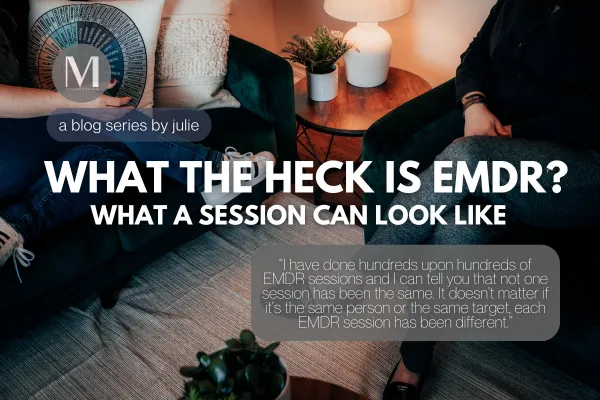the blog
A place for our team to share about topics they are passionate about, in hopes of allowing you to see and understand a bit more behind the faces on these pages.

What the Heck is EMDR? What a Session Can Look Like
I have done hundreds upon hundreds of EMDR sessions and I can tell you that not one session has been the same. It doesn’t matter if it’s the same person or the same target, each EMDR session has been different. It’s important to recognize any expectations you have coming into an EMDR session and talk them out with your therapist. Some of these expectations might be realistic and some might not be - you won’t know until you talk with your therapist.
Often the session will begin with a check in about how you’re doing, how the week was, and how you’re feeling about starting EMDR processing. From there, we pick which target from your target sequence plan that you’d like to start with, and we set up the target. Setting up the target means that we bring it online by asking about what the worst part was, what the emotion connected to it is, whether the negative belief we identified originally still fits or if there is a different one, and how disturbing the incident is to you now when you think about it. We identify what you’d like to believe about yourself, and how true that statement feels to you. Once we have that information we have you go to that memory in your mind, and once you have it we start the bilateral stimulation.
We do bilateral anywhere from 5 seconds to 1 minute, depending on the client. We then pause the bilateral stimulation, tell you to take a deep breath and ask you a question. We then tell you to “go with that.” Go with that just means we’re going to let your brain, body, and emotions continue along the memory however it needs to.
I will often tell clients that I want them to imagine being on a train. When the train is moving, the bilateral stimulation is happening. When the bilateral stops is when we pull into the train station. When I ask client’s what do they notice, I want them to tell me the first thing they notice at the train station, not everything that they just saw while the train was moving. When I say “go with that” I mean that we’re going to start the train again and we’re going to continue along the track.
When we’re nearing the end of the session, we will start to close down processing. If the memory is processed and now neutral or much less distressing we’ll install the positive beliefs that the client would like to believe about themselves. If the incident isn’t neutral yet, we’ll put it away in the container and I like to ask my clients what the “golden nugget” is from the session. The golden nugget is a nugget of goodness that they can take away from the session. Sometimes this looks like a feeling of “oh, I can do this,” or “It actually wasn’t my fault,” or “I’m going to be ok,” or a dozen other things. We then just focus on this golden nugget for a little bit so the client ends the session on a positive note.
We usually finish the session with some grounding exercises, as well as verbally debriefing how they’re doing, what is happening for them, and any dots that connected for them. I often tell people to journal anything new that comes up for them in between sessions, and jot down any dreams they may have that they feel are significant to the processing. Sometimes people dream and sometimes they don’t, each person is different. Through all of that, it’s important to remember that each session is different, and though this is fairly standard about what to expect there are lots of sessions that I do with clients that look nothing like this because the client wants to do it a different way, or we’ve discovered that another way of processing is better for that client. So as much as this may be insightful, don’t hold your therapist 100% to it.
Office Location: 1200 Brock Street South, Whitby, ON. L1N 4L9
© Marquis Counselling & Consulting | ALL RIGHTS RESERVED | TERMS & CONDITIONS | PRIVACY POLICY

